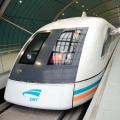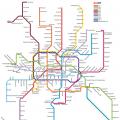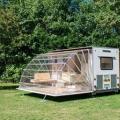)
41 people / km²
South Africa Republic (SOUTH AFRICA; africa. Republiek van Suid-Afrika, eng. Republic of South Africa) - a state in the southern part of the African continent. In the north it borders with Namibia, Botswana and Zimbabwe, in the northeast - with Mozambique and Swaziland. Inside the territory of South Africa is the state-enclave of Lesotho.
South Africa is one of the most nationally diverse countries in Africa and has the largest proportions of white, Asian and mixed populations on the continent. The country is rich mineral resources and is also the most economically developed in Africa and has a relatively strong global position.
The most important point in the history and politics of South Africa was the racial conflict between the black majority and the white minority. It culminated with the establishment of the apartheid regime in 1948, which lasted until the 1990s. The initiator of the introduction of discriminatory laws was the National Party (in the USSR it was called the Nationalist Party). This policy led to a long and bloody struggle, led by black activists such as Steve Biko and Nelson Mandela. Later they were joined by many white and colored (descendants of a mixed population), as well as South Africans of Indian descent. Pressure from the international community also played a role in the collapse of apartheid. As a result, the change political system happened relatively peacefully: South Africa is one of the few African countries where a coup d'etat has never been carried out.
"New South Africa" is often referred to as "Rainbow Country", a term coined by Archbishop Desmond Tutu (and endorsed by Nelson Mandela) as a metaphor for a new, multicultural and multicultural society that overcomes divisions dating back to the apartheid era.
During apartheid in South Africa, members of the African National Congress used the word “ Azania»To designate their country as an alternative to the then unacceptable official name. The word "Azania" was also used as the name of South Africa in the official Chinese diplomatic vocabulary at a time when South Africa maintained diplomatic relations with Taiwan (not recognized by China).
South Africa has a variety of climatic zones, from the dry Namib desert to the subtropics in the east near the border with Mozambique and the Indian Ocean coast. In the east, the area rises rapidly to form the Drakensberg Mountains and into a large inland plateau called the veld.
The interior of South Africa is a vast, relatively flat and sparsely populated area known as the Karoo, which becomes arid as it approaches the Namib Desert. On the contrary, the east coast is beautifully humid and has a climate close to tropical. In the extreme southwest of the country, the climate is extremely Mediterranean-like, with rainy winters and hot, dry summers. It is here that South African wine is mainly produced. The region is also known for the constant winds that blow throughout the year. This wind in the area of the Cape of Good Hope is so strong that it always caused a lot of inconvenience to sailors and often led to shipwrecks. Further to the east, precipitation falls more evenly, so there is already more vegetation, the region is known as the "Path of the Gardens".
Languages and official names
Due to the fact that 11 languages \ u200b \ u200bare recognized as state languages in South Africa (the third country in terms of the number of languages after India and Bolivia), South Africa has 11 official names:
- Republiek van Suid-Afrika(Afrikaans)
- Republic of South Africa(English)
- IRiphabliki yeSewula Afrika(southern ndebele)
- IRiphabliki yaseMzantsi Afrika(braid)
- IRiphabliki yaseNingizimu Afrika(zulu)
- Rephaboliki ya Afrika-Borwa(northern soto)
- Rephaboliki ya Afrika Borwa(sesotho)
- Rephaboliki ya Aforika Borwa(tswana)
- IRiphabhulikhi ye Ningizimu Afrika(swazi)
- Riphabuḽiki ya Afurika Tshipembe (venda)
- Riphabliki ra Afrika Dzonga(tsonga)
Despite such a wide range, some South Africans eschew official names and prefer to call the country Azania: These are mainly black racists seeking to distance themselves from the European colonial heritage.
Dutch and kosa
The first written mention of the permanent settlement of Europeans dates back to April 6, 1652, when Jan van Riebeck, on behalf of the Dutch East India Company, founded a settlement on the "Cape of Storms", later called " Good Hope"(Now Cape Town). In the XVII and XVIII centuries colonists from the Netherlands arrived in South Africa, as well as French Huguenots fleeing religious persecution in their homeland, and settlers from Germany. In the 1770s. the colonists encountered the kosa, advancing from the northeast. A series of clashes ensued, known as the border ("kaffir") wars, mainly caused by the claims of white settlers on African lands. Slaves from other Dutch possessions, in particular, from Indonesia and from Madagascar, were also brought to the Cape Colony. Many slaves, as well as the autochthonous population of the Cape, mingled with the white colonists. Their descendants are called "Cape Colored" and now account for up to 50% of the population in the Western Cape.
British colonization
Boer Wars
The discovery of rich deposits of diamonds () and gold () on the Witwatersrand led to the economic growth of the colony and an increase in capital outflow to Europe, a sharp increase in immigration to the Boer republics and a deterioration in the situation of the natives. These events, provoked and encouraged by the British government, eventually led to a conflict between the British and the Boers. In -1881, the first Anglo-Boer war took place, during which the Boers were able to defend their independence largely due to Britain's disinterest in dragging it into a protracted colonial war, since the territories of the Orange Republic and the Transvaal were not of significant strategic interest at that time, despite for the discovery by that time of a diamond deposit in the Kimberley area. The "gold rush" in the rand (Johannesburg area) began after the first Boer War. It should also be noted that the British colonial troops were few in number during that period. So, the annexation of the Transvaal by Great Britain in 1877, which was the direct cause of the war, was carried out by an English detachment of only 25 people without a single shot.
At the same time, the British established themselves in Natal and Zululand, winning the war against the Zulu. In -1902, the second Boer War took place, in which the Boers, despite initial successes, still lost to the better trained and equipped British, who had an overwhelming numerical advantage. After the defeat of their irregulars, the Boers, under the command of Louis Botha, Jacob Delarey and Christian De Wet, turned to guerrilla warfare tactics that the British fought by creating a network of blockhouses, as well as collecting Boer women and children in concentration camps, or using armored trains to fight the guerrillas. ... Under the terms of the agreement in Feriniching, the British agreed to pay three million (in reality - nine million compensation) for the ruin of Boer farms and agricultural land, which amounted to no more than 20% of the damage caused. In addition, blacks were still denied the right to vote (except in the Cape Colony).
The war found its reflection in the famous works of world literature - in the novels of Louis Boussinard "Captain Tear the Head" and "The Diamond Thieves", where the Boers were presented as victims of the violent colonization policy of Great Britain, and in the historical work of A. Conan Doyle "The War in South Africa ", which more defends the policy of the British (despite the author's efforts to be not biased, the book was used by the British government for propaganda purposes) and in the Russian novel by an unknown author" Rose Burger - Boer Heroine, or Gold Miners in the Transvaal. "
Creation of the Union of South Africa
After four years of negotiations, on May 31, 1910, the Union of South Africa was formed, which included the British Cape Colony, Natal, the Orange River Colony and the Transvaal. He became the dominion of the British Empire. In 1914, South Africa entered the First World War. In 1934, the United Party was formed, which united the South African Party (pro-British) and the National Party (Boer). In 1939, it collapsed due to disagreements about whether South Africa should follow Great Britain into World War II - the right-wing National Party sympathized with the Third Reich and advocated sharp racial segregation.
South African independence
Apartheid and its aftermath
Population
In terms of population, South Africa is in 26th place in the world - 49.9 million people live in the country (as of July 2010).
Over the past two decades, the country's population has remained almost unchanged (a slight decrease) due to the high infection with HIV, as well as the decline in the number of whites.
The average life expectancy is 50 years for men, 48 years for women.
Ethno-racial composition (according to the 2010 census):
- Blacks - 79.4%
- colored (mostly mulattoes) - 8.8%
- Indians and Asians - 2.6%
State structure
Administrative division
South Africa is now unitary state... The country's territory is divided into 9 provinces (administrative centers):
Included in an international organization ACP countries.
Work force
Of the 49 million people in South Africa, only 18 million are able to work. Unemployed - 23% (in 2008).
65% of the working population is employed in the service sector, 26% in industry, 9% in agriculture (in 2008).
Branches of the national economy
Extractive industry
South Africa owes much of its rapid development to wealth natural resources... About 52% of exports are from the mining industry. Manganese, platinum group metals, gold, chromites, aluminoglucates, vanadium and zirconium are widely mined. Coal mining is very developed - in the use of coal for the production of electricity, South Africa ranks third in the world (due to the lack of oil, about 80% of all energy production in South Africa is based on coal combustion). In addition, reserves of diamonds, asbestos, nickel, lead, uranium and other important minerals are concentrated in the country.
Agriculture
Since most of the country has an arid climate, only 15% of its area is suitable for agriculture. However, it can be said that unlike most other countries in Africa, where soil erosion occurs, this 15% is used wisely - for the purpose of soil protection and effective agriculture, the advanced agrotechnical achievements of South Africa and the leading countries of the world are applied. This led to amazing results: South Africa fully meets domestic food needs, and is also one of the leading (and in some respects leading) suppliers of agricultural products - the country exports about 140 types of fruits.
Winemaking
In South Africa, there are three zones for winemaking. Northwest (North Cape - Cape) and East Coast(KwaZulu-Natal) is not considered to be the source of the best wines as it has a very hot and arid climate. But the Southwest of South Africa (Western Cape) has a wonderful climate for winemaking.
Livestock
Meat and dairy production is concentrated in the north and east of the Free State province, in the interior of Hoteng province and in the southern part of Mpumalanga province. Meat breeds are widespread in the Northern and Eastern Cape. The drylands of the Northern and Eastern Cape, the Free State and Mpumalanga contain sheep breeding areas. The skins of astrakhan sheep are supplied to the world market.
Goats are bred in large numbers, mostly - 75% - Angora, whose wool is highly valued in the West (up to 50% of the world production of mohair is in South Africa). The other most common breed is the Boer goat, which is bred for meat. In terms of sheared goat hair (92 thousand tons per year), South Africa ranks 4th in the world.
Compared with such predominantly extensive subsectors as cattle and sheep breeding, poultry and pig breeding are more intensive and are common on farms near major cities- Pretoria, Johannesburg, Durban, Pietermaritzburg, Cape Town and Port Elizabeth.
V last years- mainly in the province of the Free State - ostrich breeding is actively developing. Export from South Africa of meat, skin and feathers of this bird is gradually increasing.
Fishing
In terms of fish catch (about 1 million tons per year), South Africa takes the leading place in Africa. The main fishing objects are sardines, herring, hake, anchovy, sea bass, mackerel, cod, Cape salmon, mackerel, monkfish. In addition, shrimps, lobsters, tuna fish, lobsters, oysters, octopuses, sharks, whose fins are in demand in countries South-East Asia as well as the Cape seal. Fishing is carried out mainly in west coast South Africa, washed by the Benguela Ocean Current, in a fishing area 200 nautical miles wide. About 40% of the catch comes from freshwater fish caught in the rivers Elands, Limpopo and others, as well as by breeding in artificial reservoirs.
Forestry
The main zone is the southern part of the KwaZulu-Natal province. Natural forests occupy 180 thousand hectares, that is, only 0.14% of the country's territory. Most of the commercial timber comes from plantations, which account for only 1% of the territory of South Africa. About half of the forest "plantations" are planted with pine, 40% with eucalyptus and 10% with mimosa. Yellow and ebony trees, Cape laurel, Assegai and Kamassi are also grown. Trees reach a commercial condition on average in 20 years - in contrast to trees growing in the Northern Hemisphere, where this process lasts from 80 to 100 years. The annual volume of timber supplied to the market is 17 million cubic meters. m. More than 240 woodworking and timber processing enterprises operate in South Africa.
Agriculture accounts for 35-40% of all exports, which is 5% of South Africa's GDP.
State economic policy
The economic policy of the state is aimed at stabilizing the economy. According to statistics from The Heritage Foundation, the republic is in 57th position in the world in terms of economic freedom. South Africa has a relatively high income tax (up to 40% depending on the level of income).
See also: The largest companies South Africa
Culture
South African culture is traditionally diverse. First of all, it is a combination of two cultures: traditional and modern.
Traditional culture
Many indigenous peoples such as the Bantu, Bushmen and Hottentots contributed to it. Protea flower is the national symbol of South Africa.
Modern culture
Art
During the colonial period, South African artists, the most significant of whom was Thomas Baines, saw it as their task to accurately convey the realities of the “new world” in the context of European culture with the aim of transmitting this information back to the metropolis. Only in late XIX century, artists appeared, primarily Jan Wolschenk, Hugo Naude and the sculptor Anton van Voe, whose goal was to create a new art based on South African (in this case Boer) traditions. In the 1920s, Jacob-Hendrik Pirnef brought modernism to South African art.
In the 1930s, black artists began to come to the fore. Gerard Sekoto, who has lived in France since 1947, and George Pemba are considered one of the founders of the genre of black urban art.
A prominent representative of the developing musical rap culture of South Africa is the group Die Antwoord, who call their style of music "zef-rap".
Sport
The country hosts an annual cycle race, which brings together leading athletes from all over the world.
Highly popular species sports in the country are rugby football. The South African national rugby team is a two-time World Cup winner (1995, 2007).
South Africa.
The name of the country is due geographic location country.
South Africa area... 1,221,000 km2.
Population of South Africa... 46000 thousand people
Administrative divisions of South Africa... The state is divided into 9 provinces.
Form of government of South Africa... Republic.
Head of State of South Africa... The president.
Supreme Legislature of South Africa... Bicameral Parliament - National Assembly and National Council of Provinces.
Higher executive agency South Africa... Government.
Ethnic composition of South Africa... 77% are Africans, 12% are Europeans and their descendants, 11% are Asians.
South African currency... Rand = 100 cents.
South Africa climate... There are 20 climatic zones on the territory of the state. The region of the Natal province is distinguished by an elevated, which is inherent in a hot tropical. The Cape Town area is characterized by dry, hot summers and mild winters. For the rest of the state, the climate is typical. The climate in South Africa is more than in other countries located at the same latitudes - this is due to the sufficient height above sea level and the proximity of ocean currents. most falls in the east (1000-2000 mm per year), least of all - by (less than 100 mm).
Flora South Africa. Vegetable world South Africa is rich - at least 20,000 plant species grow here. From here, many flowers that are now common in were once taken out - among them geranium, gladiolus, daffodil. The Cape Town area is home to over 5,000 plant species that no longer grow in any country in the world. A silvery tree has survived, the flower of which is the national symbol of South Africa. The main part of the country is.
Fauna of South Africa... Among the representatives of the animal world of South Africa there are elephants, rhinoceros, zebra, lion, giraffe, cheetah, aardvark, antelope, hyena, golden eagle, tarsier, and various species of birds. and lakes. Largest rivers- and . Sights. Cape Town - Castle of Good Hope, South African Museum, which displays archaeological finds in the vicinity and samples rock painting bushmen.
Useful information for tourists
Gratuities in the restaurant are 10-12% of the total order value (including drinks), porter service is from 2 to 5 rand per piece of luggage, guide-driver is 15-20 rand per person per day of work. You do not need to get any vaccinations unless you are planning a trip to the northeastern regions (areas where the anopheles mosquito is spread). Long-sleeved clothing and insecticides are recommended along with taking antimalarial drugs. Malaria mosquitoes are most active at dusk. Air conditioners and fans also reduce the risk of mosquito bites.
South Africa Republic (SOUTH AFRICA; africa. Republiek van Suid-Afrika, eng. Republic of South Africa) - the state in. In the north it borders with, and, in the northeast - with and. Inside the territory of South Africa there is an enclave state.
South Africa is one of the most nationally diverse countries in Africa and has the largest proportions of white, Asian and mixed populations on the continent. The country is rich in mineral resources and is also the most economically developed in Africa and has a relatively strong global position. The only one African country in the G20.
The most important point in the history and politics of South Africa was the racial conflict between the black majority and the white minority. It culminated with the establishment of the apartheid regime in 1948, which lasted until the 1990s. The initiator of the introduction of discriminatory laws was the National Party (in the USSR it was called the Nationalist Party). This policy led to a long and bloody struggle, led by black activists such as Steve Biko, Desmond Tutu and Nelson Mandela. Later they were joined by many white and colored (descendants of a mixed population), as well as South Africans of Indian descent. Pressure from the international community also played a role in the collapse of apartheid. As a result, the change in the political system took place relatively peacefully: South Africa is one of the few African countries where a coup d'etat has never been carried out.
New South Africa is often called the Rainbow Country, a term coined by Archbishop Desmond Tutu (and endorsed by Nelson Mandela) as a metaphor for a new, multicultural and multi-ethnic society that overcomes divisions dating back to the apartheid era.
During apartheid in South Africa, members of the African National Congress used the word “ Azania»To designate their country, as an alternative to the official name unacceptable for them then. The word "Azania" was also used as the name of South Africa in the official Chinese diplomatic vocabulary at a time when South Africa maintained diplomatic relations with (unrecognized China).
South Africa is the first state to have, but voluntarily renounced nuclear weapons.
Languages and official names
Due to the fact that 11 languages \ u200b \ u200bare recognized as state languages in South Africa (the third country in terms of the number of official languages after i), South Africa has 11 official names:
- Republiek van Suid-Afrika(Afrikaans),
- Republic of South Africa(English),
- IRiphabliki yeSewula Afrika(southern ndebele),
- IRiphabliki yaseMzantsi Afrika(braid),
- IRiphabliki yaseNingizimu Afrika(zulu),
- Rephaboliki ya Afrika-Borwa(northern soto),
- Rephaboliki ya Afrika Borwa(sesotho),
- Rephaboliki ya Aforika Borwa(tswana),
- IRiphabhulikhi ye Ningizimu Afrika(swazi),
- Riphabuḽiki ya Afurika Tshipembe (venda),
- Riphabliki ra Afrika Dzonga(tsonga).
Despite such a wide range, some South Africans eschew official names and prefer to call the country Azania, mostly black racists seeking to distance themselves from the European colonial heritage.
The Creole language iskamto (formerly known as zocytal, literally "thieves' tongue"), which is widespread among black urban youth in the townships of the province in the east of the country (mainly), has no official recognition and is banned in schools. However, young people often speak tsotsital better than their ethnic languages. From this language comes the word Tsotsi - the name of the protagonist of the South African film of the same name.
Geography
South Africa is located at the southern tip. Length coastline of the country is 2 798 km. South Africa has an area of 1,221,038 km² and is ranked 24th in the world for this indicator. Highest point South Africa - Mount Njesuti in the Drakensberg Mountains.
South Africa has a variety of climatic zones, from the dry Namib desert to the subtropics in the east near the border with and the coast of the Indian Ocean. To the east, the area rises rapidly to form the Drakensberg Mountains and into a large inland plateau called the veld.
The interior of South Africa is a vast, relatively flat and sparsely populated area known as the Karoo, which becomes arid as it approaches the Namib Desert. On the contrary, the east coast is perfectly humid and has a climate close to tropical. In the extreme southwest of the country, the climate is extremely Mediterranean-like, with rainy winters and hot, dry summers. It is here that South African wine is mainly produced. The region is also known for the constant winds that blow throughout the year. This wind in the area of the Cape of Good Hope is so strong that it always caused a lot of inconvenience to sailors and often led to shipwrecks. Further to the east, precipitation falls more evenly, so there is already more vegetation, the region is known as the "Path of the Gardens".
The Free State area is a particularly flat area, located in the heart of a high plateau. North of the Vaal Weld River is better humidified without being exposed to too high temperatures. , located in the center of Welda at an altitude of 1740 meters, receives 760 mm of precipitation per year. In these places, winters are cold, although snow rarely falls.
North of Johannesburg, the high Weld Plateau merges into Bushveld, a relatively low altitude region of dry mixed forests... To the east of High Veld, Low Veld descends to the Indian Ocean, which is characterized by high temperatures; Intensive farming is carried out in this region. From the southeast, Weld is bounded by the high Drakensberg Mountains, where you can practice skiing. It is often believed that the coldest place in the country is Sutherland in the west of the Roggeveld Ridge, where in winter temperatures can reach -15 ° C, but in fact the most low temperatures attested at Beffelsfontein (): −18.6 ° C. The highest temperatures are found in the interior of the country: in the Kalahari near in 1948, a temperature of +51.7 ° C was recorded.
On the east coast up to 30 ° S. NS. Savannah and gallery forests prevail along the rivers, to the south - subtropical forests and shrubs. The interior is occupied by the deserted Kalahari savanna, shrub semi-deserts and Karoo deserts. Among the animals there are golden moles, tarsiers, aardvarks, jumper antelope, quagga, brown hyena. More rare are elephants, rhinos, zebras, giraffes, lions, ostriches.
History
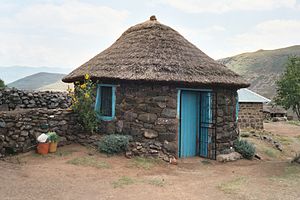
Rondawel is a typical home of the Bantu peoples in South Africa
Man appeared on the territory of the country in ancient times (as evidenced by the finds in caves near Sterkfontein, Kromdray and Makapanshat). However, there is very little reliable information about the early history of this region. Before the arrival of the Bantu tribes (they reached the Limpopo River in the north of the country in the middle of the 1st millennium AD), this territory was inhabited by nomadic cattle-breeding tribes of Koi-koin (Hottentots) and gatherers-Bushmen (San). Bantu farmers moved southwestward, destroying or assimilating the local population. Archaeological evidence of their presence in the present province of KwaZulu-Natal dates back to around 1050. By the time of the arrival of the Europeans, the area of the Cape of Good Hope was inhabited by the Koi-coin, and the Bantu (Kosa tribes) reached the banks of the Great Fish River. Local peoples were familiar with the extraction of metal ores, processing and making tools from iron and copper.
Dutch and kosa

Arrival of Jan van Riebeck
The first written mention of the permanent settlement of Europeans dates back to April 6, 1652, when Jan van Riebeck, on behalf of the Dutch East India Company, founded a settlement at Cape Storms, later called Good Hope (now). In the 17th and 18th centuries, colonists from the Netherlands arrived in South Africa, as well as French Huguenots fleeing religious persecution in their homeland, and settlers from Germany. In the 1770s. the colonists encountered the kosa, advancing from the northeast. A series of clashes ensued, known as the border (kaffir) wars, mainly caused by claims of white settlers over African lands. Slaves from other Dutch possessions were also brought to the Cape Colony, in particular from Indonesia and s. Many slaves, as well as the autochthonous population of the Cape, mingled with the white colonists. Their descendants are called Cape Colored and now account for up to 50% of the population.
British colonization
First gained dominion over the Cape Colony in 1795, during the Fourth Anglo-Dutch War: then they fell under the rule of Napoleon, and the British, fearing that the French would gain control over this strategically important region, sent an army to Kapstad under the command of General James Henry Craig. that he seized the colony on behalf of stadtholder William V. The governor of Kapstad did not receive any instructions, however, agreed to obey the British. In 1803, the Peace of Amiens was concluded, under the terms of which the Batavian Republic (that is, the Netherlands, as they began to be called after the French conquest) left the Cape Colony for itself. After the resumption of the war in 1805, the British decided to seize the colony again. As a result of the battle on the slopes of Table Mountain in 1806, British troops under the command of David Byrd entered the Kapstad fort.
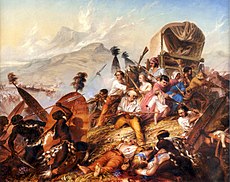
Zulus, 1838 r.
The British have consolidated their presence in eastern border Cape Colony, fighting the scythe by building forts along the banks of the Great Fish River. To strengthen its power in these places, the British crown encouraged the arrival of settlers from the metropolis.
In 1806, under pressure from various forces within the country, the British Parliament banned slavery, and in 1833 this provision was extended to the colonies. Constant clashes at the borders, the abolition of slavery and other disagreements with the British forced many peasants of Dutch origin (called Boers, from the Dutch. "Boer" ⎯ "peasant") to go to the so-called Great Track inland, to the high Weld plateau. There they encountered the Ndebele chiefdom, led by Mzilikazi, a former associate of Chaka, who fled to the west during the so-called Mfekane, a migration of peoples caused by internecine wars in Southeast Africa (present-day KwaZulu-Natal province). In the end, the Boers established their states in the continental part of South Africa: and the Transvaal.
Boer Wars
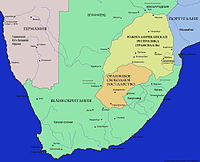
Territory of South Africa before the second Boer War

Boer soldiers dig trenches during the Boer War

Boers at Spion Kop
The discovery of rich diamond deposits (1867) and gold (1886) on the Witwatersrand led to the economic growth of the colony and an increase in capital outflows, a sharp increase in immigration to the Boer republics and a deterioration in the situation of the natives. These events, provoked and encouraged by the British government, eventually led to a conflict between the British and the Boers. In 1880 - 1881, the First Anglo-Boer War took place, during which the Boers were able to defend their independence largely due to the reluctance of Great Britain to wage a protracted colonial war, since the territories of the Orange Republic and the Transvaal were not of significant strategic interest, despite the discovery to that time of diamond deposits in the Kimberley area. The gold rush in the rand (Johannesburg area) began after the First Boer War. It is impossible not to note the small number of British colonial troops during that period. So, the annexation of the Transvaal by Great Britain in 1877, which was the direct cause of the war, was carried out by an English detachment of only 25 people without a single shot.
At the same time, the British established themselves in Natal and Zululand, winning the war against the Zulu. In 1899 - 1902, the Second Boer War took place, in which the Boers, despite initial successes, still lost to the better trained and equipped British, who had an overwhelming numerical advantage. After the defeat of their irregulars, the Boers, under the command of Louis Botha, Jacob Delarey and Christian De Veth, turned to guerrilla tactics that the British fought by creating a network of blockhouses, as well as collecting Boer women and children in concentration camps, or using armored trains to combat partisans. Under the terms of the agreement, the British agreed to pay three million (in reality - nine million compensation) for the ruin of Boer farms and agricultural land, which amounted to no more than 20% of the damage caused. In addition, blacks were still denied the right to vote (except in the Cape Colony).
The war was reflected in the famous works of world literature: in the novels of Louis Boussinard "Captain Rip the Head" and "The Diamond Thieves", where the Boers were presented as victims of the violent colonization policy of Great Britain, and in the historical work of A. Conan Doyle "The War in South Africa ", which more defends the policy of the British (despite the author's efforts to be impartial, the book was used by the British government for propaganda purposes) and in the Russian novel by an unknown author" Rose Burger - the Boer heroine, or gold diggers in the Transvaal. "
Creation of the Union of South Africa
After four years of negotiations, on May 31, 1910, the Union of South Africa was formed, which included the British Cape Colonies, the colonies of Natal, the Orange River and the Transvaal. Union became dominion British Empire... In 1914, JAS entered the First world war... In 1934, the United Party was formed, which united the South African Party (pro-British) and the National Party (Boer). In 1939, it collapsed due to disagreements about whether South Africa should follow Great Britain into World War II - the right-wing National Party sympathized with the Third Reich and advocated sharp racial segregation.
South African independence
In 1961, the Union of South Africa became an independent South African Republic, which seceded from the Commonwealth of Nations, led by Great Britain. The withdrawal was due to the rejection of the apartheid policy in South Africa by other members of the Commonwealth (South Africa's membership in the Commonwealth was restored in June 1994).
Apartheid and its aftermath
In 1948, the National Party won the election and passed several very strict laws restricting the rights of blacks: the ultimate goal of this policy was to create a "South Africa for whites", while the blacks were supposed to be completely deprived of South African citizenship.
During apartheid, blacks were effectively deprived of the following rights in part or in whole:
- for South African citizenship (in most cases this has become a privilege),
- participate in elections and be elected,
- to freedom of movement ( blacks were forbidden to go outside after sunset, as well as to appear in the "white" areas without special permission from the authorities, that is, in fact, they were forbidden to visit large cities, since they were in the "white" areas),
- for mixed marriages,
- for medical care ( this right was not formally taken away from them, but they were forbidden to use medicine "for whites", while medicine "for blacks" was completely undeveloped, and in some areas it was completely absent),
- for education ( the main educational institutions were in "white" areas),
- to be hired ( employers were officially granted the right to apply racial discrimination in recruitment).

Nelson Mandela and Frederic de Klerk, 1992.
In addition, communist parties were banned during apartheid - membership in the communist party was punishable by 9 years in prison. The UN has repeatedly recognized apartheid as South African fascism in its resolutions and called on South Africa to end the policy of racial discrimination. However, South Africa was oblivious to these demands. The world community sharply condemned the existing regime and imposed sanctions on South Africa, for example, banned participation in the Olympic Games. One of the consequences of apartheid was a huge social gap between the descendants of Europeans, who lived by the best standards. western world, and the majority, who were in poverty (though not nearly as deep as in many other African states). All this caused protests, strikes and unrest within the country, the peaks of which fell in the mid-50s, early 60s, mid-70s and 80s, as well as anxiety in the international community, which threatened the country with sanctions. In September 1989, Frederic de Klerk was elected president of the country, who began to take active steps to eliminate the apartheid system (the white population had to abandon its dominant position). Many laws were canceled, and Nelson Mandela was released from prison. In 1994, the first general elections were held, which was won by the African National Congress, which is still in power.
Despite the end of apartheid, millions of black South Africans still live in poverty. This is due to the fact that, due to historical reasons in terms of education, social responsibility and labor productivity, the majority of indigenous black Africans at the current stage are objectively unable to meet the standards of a developed post-industrial society. The level of street crime is extremely high, including the percentage of serious crimes, however, the authorities refuse to give in to the wishes of society and introduce the death penalty. True, the social housing program has borne some fruit, improving the living conditions of many citizens, which has led to an increase in tax collection.

Leaders of the BRICS countries in 2014
At the beginning of the 21st century, the problem of illegal migration also became very acute in South Africa. After the abolition of apartheid and a significant weakening of control at the external borders, a stream of illegal immigrants poured into the country from, and other countries. In total in South Africa (at the beginning of 2008), according to various experts, there are from 3 to 5 million illegal migrants. The massive influx of foreigners is causing discontent among South African citizens. The claims against migrants are mainly that they take away jobs from South African citizens, agreeing to work for lower wages, and also commit various crimes.
In May 2008, mass demonstrations by South Africans against migrants took place. Groups armed with clubs, stones and melee weapons local population beat and kill migrants. During the week of riots in Johannesburg alone, more than 20 people were killed and thousands left their homes. Migrants were forced to hide from angry local residents in police stations, mosques and churches. The local police practically completely lost control over the situation and were forced to turn to the president of the country with a request to involve the army to restore order. On May 22, 2008, South African President Thabo Mbeki authorized the use of troops to suppress unrest in the country. For the first time since the abolition of apartheid, the South African army was used against the citizens of their own state.
State structure
Form of government
South Africa is parliamentary. The president should rely on the support of parliament in almost all his decisions on most issues. A citizen of South Africa over 30 years old can become a presidential candidate.
South Africa has a bicameral parliament, consisting of the National Council of Provinces (upper house - 90 members) and the National Assembly (400 members). Members of the lower house are elected according to a proportional voting system: half of the deputies go on national lists, half on provincial lists. Each province, regardless of population, sends ten members to the National Council of Provinces. Elections are held every five years. The government is formed in the lower house, and the leader of the party that received the majority in it becomes president (now Jacob Zuma holds this post).
South Africa's current ruling party is the African National Congress, which received 65.9% of the vote in the 2009 general election and 66.3% of the vote in the 2006 municipal election. Its main rival is the Democratic Alliance party (16.7% in 2009; 14.8% in 2006). The leader of the Democratic Alliance is Helen Zille. The new National Party, the successor to the National Party, under which the apartheid system operated, was rapidly losing weight after 1994 and on April 9, 2005, it merged with the ANC. The Parliament also includes the Inkata Freedom Party (4.6%), representing mainly Zulu voters, and the People's Congress (7.4%).
Ministries
- South African Ministry of Basic Education.
- South African Ministry of the Interior.
- South African Ministry of Higher Education and Training.
- South African Ministry of State Enterprises.
- South African Ministry of Health.
- Ministry of Arts and Culture of South Africa.
- South African Department of Corrections.
- South African Department of Cooperative Management and Traditional Affairs.
- South African Ministry of Science and Technology.
- Department of Defense and Military Veterans of South Africa.
- Ministry of Public Works of South Africa.
- Ministry the environment SOUTH AFRICA.
- South African Department of Water Resources.
- South African Ministry of Police.
- South African Ministry of Communications.
- South African Ministry of Agriculture, Fisheries and Fisheries.
- South African Department of Rural Development and Land Reform.
- South African Department of Trade and Industry.
- South African Department of Transport.
- South African Ministry of Tourism.
- South African Department of Justice and Constitutional Development.
Military establishment
The National Defense Forces were created in 1994 following the first post-apartheid national elections and the adoption of a new constitution, replacing the South African Defense Force (SADF).
Types of armed forces
Ground Forces (eng. South African Army). Naval forces (eng. South African Navy). Air Force (eng. South African Air Force).Right
The legal system of South Africa has absorbed the elements of three legal families distinguished today: Romano-Germanic, Anglo-Saxon and traditional. In general, in modern South Africa, Romano-Germanic law prevails, that is, there is the rule of law over all legal decisions and a clear division of law into private and public. The country has a Constitution adopted in 1996. It protects and guarantees all internationally recognized human rights. But South African law has not always been humane and tolerant. For a long time it found its reinforcement of discrimination against the black population, which was called "apartheid". As a result of the collapse of the political foundation of apartheid and the subsequent lengthy legislative processes in the 1990s, the South African legal system was completely revised, and all racial discrimination was excluded from it. In 1994, the Constitutional Court was established in the country.
Criminal law
The Republic of South Africa is one of the few countries where criminal law is based on the English model. It is not codified. The judicial system consists of the following instances: the Supreme Court of Appeal, the high courts and the magistrates' courts. The Supreme Court of Appeal is the main court in South Africa for criminal matters. It is located in the "judicial capital" of the country. Under the apartheid regime, there were separate local courts for the black population ("chief courts"), in which the judges were also predominantly black. At the same time, the overall judicial system the overwhelming majority of the judges were white. Particularly harsh penalties were provided for opponents of the political regime - up to the death penalty. It was allowed to detain people for 5 days without trial or investigation. After the fall of apartheid, many norms were revised. In 1994, the Internal Security Act was repealed, in 1995 - the death penalty, and in 1997 - legal flogging. When revised legal system in the 90s, homosexual marriage was legalized in the country, which makes it the only country of this kind in Africa.
(Until 1994, South Africa was a federation and was divided into 4 provinces: Cape, Natal, Orange Free State and Transvaal. This division reflected well the colonial past of South Africa. The first was divided into 3 parts, the last into 4, with part of the territory in the north moved from the Eastern Cape (part of the former Cape) to the North-Western (part of the former Transvaal) The remaining two practically retained their outlines.
In addition, from 1951 to 1994, the so-called bantustans existed in South Africa - autonomies set aside for the residence of certain nationalities. Outside the Bantustans, the rights of the black population were significantly limited. Four of them received "independence" (in this regard, their residents were deprived of South African citizenship), which, however, was not recognized by any state except South Africa:
- Bophutatswana (tswana) - "independence" from December 6, 1977
- Transkei (spit) - "independence" from October 26, 1976
- Siskei (spit) - "independence" from December 4, 1981
- Venda (Venda) - "independence" from September 13, 1979
Other bantustans were under the jurisdiction of South Africa:
- Gazankulu (tsonga)
- Kangwane (swazi)
- Quandebele (Ndebele)
- KwaZulu (Zulus)
- Lebowa (northern sotho)
- Heron (southern soto)
Capital

University of Pretoria
It is officially considered the main capital of South Africa, since the country's government is located there. The other two branches of government are located in two other cities: Parliament in, Supreme Court in. They are also considered capitals. This is due to the fact that initially South Africa was a confederate state, in this regard, during the formation of the Union of South Africa (from the British possessions with the capital in Cape Town, the Orange Free State with the capital in Bloemfontein and the South African Republic (Transvaal) with the capital in Pretoria) the authorities were evenly distributed over the capitals of the states included in it.
It is sometimes claimed that Pretoria was renamed Tshwana. This is not true: Tshvane is the name of a city municipality, an administrative unit one level below the province (in this case, we are talking about a province). The municipality of Tshvane includes the cities of Pretoria, Centurion (formerly Verwurdburg), Soshanguwe and a number of smaller regions.
Demography
Population

Adult HIV prevalence by country in 2011 15-50% 5-15% 1-5% 0.5-1.0% 0.1-0.5%
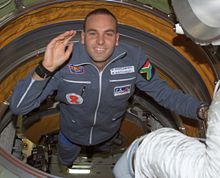
Mark Shuttleworth on the International Space Station
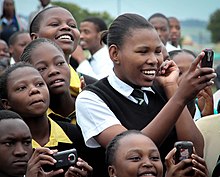
Pupils
In terms of population, South Africa is in 26th place in the world with 51.8 million people (as of July 2010). The number of whites in the country is gradually decreasing due to their emigration to, and - in 1985-2005 about 0.9 million whites left South Africa, mainly under the age of 40 and their children. The share of the black population in South Africa is growing due to the influx of black emigrants from other African countries.
Over the past two decades, the country's population has remained almost unchanged (slight increase) due to the high infection with HIV, as well as the decline in the number of whites. One of the central problems is the massive spread of HIV infection (mainly among the black population), in which South Africa ranks first in the world (according to UN data published in 2003 and 2007), while South Africa is in fourth place (after, and). In total, about 5.7 million people are infected with HIV, which is 11.7% of the country's adult population (in 2007). Because of AIDS, the death rate in South Africa has long exceeded the birth rate (in 2010, the population decline was 0.05%, with an average fertility of 2.33 births per woman).
Average life expectancy: 50 years for men, 48 years for women.
Ethnoracial composition (2011 census):
- Africans (blacks) - 79.2%,
- colored (mostly mulattoes) - 8.9%,
- white - 8.8%,
- Indians and Asians - 2.5%.
- others - 0.6%
The first census in 1911 in South Africa showed that at that time there were 22% whites, and by 1980 their figure had dropped to 18%.
Literacy of the population aged 15 and over (as of 2003):
- men - 87%,
- women - 85.7%.
Religion
The religious composition of the population is rather motley, there is no absolute religious majority in the country, adherents of various religions and worldviews live: adherents of the Zion churches (10%), Pentecostals (7.5%), Catholics (6.5%), Methodists (6.8% ), Dutch reformists (6.7%), Anglicans (3.8%), other Christians (36%), atheists (15.1%), Muslims (1.3%), adherents of other religions (2.3% ), undecided (1.4%) (2001 data). South Africa has a diocese of the Orthodox Patriarchate of Alexandria - about 35,000 believers.
Standard of living
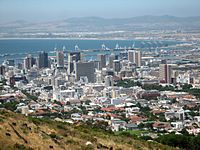
Cape Town
The average income of the population is approaching the lower limit of the average world income. However, in general economic situation society is extremely unstable. For a long time, the apartheid regime that reigned here and the preceding colonialism were reflected in the social and property stratification of society. About 15% of the population lives in the best conditions, while about 50% (mostly black) live in relatively poor conditions, which, however, are much better than the dire poverty of other African states. Not all residents have electricity and water supply, and poor sanitary conditions in many settlements contribute to the spread of various diseases. Such stark contrasts tend to strain the social environment. South Africa is very high level crime. It is mainly found in poor areas. The average life expectancy in the country is only 49.41 years (in 2012), but it has grown significantly since 2000, when it was 43 years. An unusual fact is that women have a shorter average life span than men.
In South Africa, unemployment is 40%. A third of those employed earn less than $ 2 a day. In terms of education, the country ranks 143rd out of 144. The crime rate is one of the highest in the world. The number of murders is 31 per 100 thousand population per year.
Economy and national economy

Kruger National Park
South Africa is the most developed on the African continent and at the same time the only country that does not belong to the Third World. GDP for 2015 was $ 313 billion according to the IMF (33rd place in the world), and $ 350 billion according to the World Bank (32nd place in the world). GDP growth was at the level of 5%, in 2008 - 3%. The country is still not among the developed countries of the world, despite the fact that its market is actively expanding. In terms of purchasing power parity for 2015, it ranks 30th in the world according to the IMF ($ 724 billion), according to the World Bank, 29th ($ 704 billion). Possesses huge reserves of natural resources. Telecommunications, the electric power industry, and the financial sector are widely developed.
Currency: South African rand, equal to 100 cents. The coins are in denominations of 1, 2, 5, 10, 20, 50 cents, 1, 2, 5 rands, banknotes - 10, 20, 50, 100 and 200 rands.
Main imports: oil, foodstuffs, chemical products; exports: diamonds, gold, platinum, machinery, automobiles, equipment. Imports ($ 91 billion in 2008) exceed exports ($ 86 billion in 2008).
After diplomatic relations with China were established (January 1, 1998), trade with China increased from $ 3 billion in 1998 to $ 60 billion in 2012.
It is a member of the international organization of the ACP countries.
Work force
Of the 49 million people in South Africa, only 18 million are able to work. Unemployed - 23% (in 2008).
65% of the working population is employed in the service sector, 26% in industry, 9% in agriculture (in 2008).
Branches of the national economy
Extractive industry
South Africa owes much of its advanced development to the wealth of natural resources. About 52% of exports are from the mining industry. Manganese, platinum group metals (Bushveld complex), gold, chromites, aluminoglucates, vanadium and zirconium are widely mined. Coal mining is very developed - in the use of coal for the production of electricity, South Africa ranks third in the world (due to the lack of oil, about 80% of all electricity generation in South Africa is based on coal combustion). In addition, reserves of diamonds, asbestos, nickel, lead, uranium and other important minerals are concentrated in the country.
Agriculture
Since most of the country has an arid climate, only 15% of its area is suitable for agriculture. However, it can be said that unlike most other countries in Africa, where soil erosion occurs, this 15% is used wisely - for the purpose of soil protection and effective agriculture, the advanced agrotechnical achievements of South Africa and the leading countries of the world are applied. This led to amazing results: South Africa fully meets domestic food needs, and is also one of the leading (and in some respects leading) suppliers of agricultural products - the country exports about 140 types of fruits.
Winemaking
In South Africa, there are three zones for winemaking. The Northwest (North Cape) and East Coast (KwaZulu-Natal) are not considered sources of the best wines, as they have a very hot and arid climate. But the Southwest of South Africa (Western Cape) has a wonderful climate for winemaking.
Livestock

Meat and dairy production is concentrated in the north and east of Free State, in the interior of Hoteng province and in the southern part of Mpumalanga province. Meat breeds are widespread in the Northern and Eastern Cape. The drylands of the Northern and Eastern Cape, the Free State and Mpumalanga contain sheep breeding areas. The skins of astrakhan sheep are supplied to the world market.
Goats are bred in large numbers, mostly - 75% - Angora, whose wool is highly valued in the West (up to 50% of the world production of mohair is in South Africa). The other most common breed is the Boer goat, which is bred for meat. In terms of sheared goat hair (92 thousand tons per year), South Africa ranks 4th in the world.
Compared to such predominantly extensive subsectors as cattle and sheep breeding, poultry and pig breeding are more intensive and are common on farms near large cities - Pretoria, Johannesburg, Pietermaritzburg, Cape Town and Port Elizabeth.
In recent years - mainly in the Free State province - ostrich breeding has been actively developing. Export from South Africa of meat, skin and feathers of this bird is gradually increasing.
Fishing
In terms of fish catch (about 1 million tons per year), South Africa takes the leading place in Africa. The main fishing objects are sardines, herring, hake, anchovy, sea bass, mackerel, cod, Cape salmon, mackerel, monkfish. In addition, shrimp, lobster, tuna, lobster, oysters, octopus, sharks, whose fins are in demand in the countries of Southeast Asia, as well as the Cape seal are caught. Fishing is carried out mainly off the western coast of South Africa, washed by the Benguela Ocean Current, in a fishing area 200 nautical miles wide. About 40% of the catch comes from freshwater fish caught in the rivers Elands, Limpopo and others, as well as by breeding in artificial reservoirs.
Forestry
The main zone is the southern part of the KwaZulu-Natal province. Natural forests occupy 180 thousand hectares, that is, only 0.14% of the country's territory. Most of the commercial timber comes from plantations, which account for only 1% of the territory of South Africa. About half of the forest "plantations" are planted with pine, 40% with eucalyptus and 10% with mimosa. Yellow and ebony trees, Cape laurel, Assegai and Kamassi are also grown. Trees reach a commercial condition on average in 20 years - in contrast to trees growing in the Northern Hemisphere, where this process lasts from 80 to 100 years. The annual volume of timber supplied to the market is 17 million cubic meters. m. More than 240 woodworking and timber processing enterprises operate in South Africa.
Agriculture accounts for 35-40% of all exports, which is 5% of South Africa's GDP.
Tourism
In 2010, 8.1 million tourists visited the country, and the tourism industry generated more than $ 8.7 billion in revenue.
International trade
South Africa's foreign trade is very diversified - no country as of 2010 controls more than 15% of either the exports or imports of the African state.
Major export partners (2010): China (11.3%), USA (10.1%), Japan (8.9%), Germany (8.2%), UK (5.1%), India (4.3%), Netherlands (3.3%), Switzerland (3.2%), Zimbabwe (2.9%), Mozambique (2.7%).
Major import partners (2010): China (14.4%), Germany (11.4%), USA (7.2%), Japan (5.3%), Saudi Arabia(4.1%), Iran (3.9%), Great Britain (3.8%), India (3.6%), France (3.0%), Nigeria (2.7%).
State economic policy
The economic policy of the state is aimed at stabilizing the economy. According to statistics from The Heritage Foundation, the republic is in 57th position in the world in terms of economic freedom. South Africa has a relatively high income tax (up to 40% depending on the level of income).
Culture
South African culture is traditionally diverse. First of all, it is a combination of two cultures: traditional and modern.
Traditional culture
Many indigenous peoples such as the Bantu, Bushmen and Hottentots contributed to it. Protea flower is the national symbol of South Africa.
Modern culture
Art

Jan Wolschenk, Langebergen Mountains near Riversdale in the Evening (1927).
During the colonial period, South African artists, the most significant of whom was Thomas Baines, saw their task in accurately conveying the realities of the new world in the context of European culture with the aim of transmitting this information back to the metropolis. Only at the end of the 19th century, artists appeared, primarily Jan Wolschenk, Hugo Naude and the sculptor Anton van Voe, whose goal was to create a new art based on South African (in this case Boer) traditions. In the 1920s, Jacob-Hendrik Pirnef brought modernism to South African art.
In the 1930s, black artists began to come to the fore. Gerard Sekoto, who has lived in France since 1947, and George Pemba are considered one of the founders of the genre of black urban art.
A prominent representative of the developing musical rap culture of South Africa is the group Die Antwoord, who call their style of music zef-rap.
Sport
The Comrades super marathon has been held annually since 1921. The track, 90 km long, passes through the territory of the KwaZulu-Natal province. The Comrades is the world's oldest and most massive ultra-marathon track and field event. More than 10 thousand South African and foreign athletes successfully covered The Comrades distance in 2009. The competition is open to both professionals and runners. The 2000s were triumphant for Russian runners. Such athletes as Tatyana Zhirkova, Leonid Shvetsov, Oleg Kharitonov, Elena and Olesya Nurgaliev, Marina Myshlyanova ascended the podium.
South Africa has repeatedly held the South African Grand Prix: in the period 1934-1939 with the participation of the world's leading racers of the pre-war period, and from 1962 to 1993 already in the framework of the Formula 1 World Championship. World-class races have been held on the East London and Kyalami circuits. South African Jody Scheckter in 1979, speaking for the Ferrari team, became the first and only Formula 1 world champion from. And his compatriot Desiree Wilson at the wheel of Williams in 1980 became the first and only woman in history to win a Formula 1 race. True, the stage, which was held at the Brands Hatch track, was held within the framework of the British Formula 1 Championship.

Cape Town
The country hosts an annual cycle race, which brings together leading athletes from all over the world.
Rugby and football are very popular sports in the country. The South African national rugby team is a two-time World Cup winner (1995, 2007).
In 1995, South Africa hosted the Rugby World Cup, which it won by defeating New Zealand in the final.
In 2010, South Africa hosted the FIFA World Cup.
The South African ice hockey team participated in the tournaments of the second and third divisions.
In 1993, on the recommendation of the International Fencing Federation in South Africa, Honored Coach of the USSR in fencing, Doctor of Pedagogy, Master of Sports of the USSR Gennady Tyshler (then still a candidate of pedagogical sciences) began coaching. This year can be considered the beginning of the active development of fencing in South Africa. Through the efforts of Gennady Tyshler, several well-known coaches from Russia were attracted to work in South Africa, including Mikhail Galukhin, candidate of pedagogical sciences, master of sports of the USSR. Fencing schools were opened in several large cities countries: Johannesburg, Bloemfontein, Cape Town. For the first time, South Africa took part in the World Fencing Championship, where it unexpectedly took 6th place. Since 1995, South Africa has regularly participated in all the world's largest fencing championships. The South African team also took part in the Olympic Games. Gennady Tyshler was elected president of the South African Fencing Federation; he left his post only in 2008, when, at the invitation of the current President of the International Fencing Federation Alisher Usmanov, he headed the Russian national team in appearance. And today several fencing schools are actively operating in South Africa, preparing highly qualified athletes who take part in international competitions. Athletes from South Africa consistently take prizes in the All-African Championships.
sights
- The world's largest airplane "Birds of Eden"

South Africa
General information
 The Republic of South Africa (South Africa) is a state located at the southern tip of the African continent. In the north, it borders with Namibia, Botswana and Zimbabwe, in the northeast with Mozambique and Swaziland. The Kingdom of Lesotho is completely surrounded by the territory of South Africa.
The Republic of South Africa (South Africa) is a state located at the southern tip of the African continent. In the north, it borders with Namibia, Botswana and Zimbabwe, in the northeast with Mozambique and Swaziland. The Kingdom of Lesotho is completely surrounded by the territory of South Africa.
South Africa is one of the most ethnically diverse and has the largest proportion of the continent's white population. Racial and ethnic struggles have played an important role in the history and political life of the country.
South Africa has 11 state languages, making it the second largest after India. As a result, there are several valid official country names.
There are three capitals in South Africa!
The administrative capital of South Africa is Pretoria.
Cape Town (the seat of the country's parliament) is considered the legislative capital of the Republic of South Africa.
Judicial - Bloemfontein (Constitutional Court of South Africa).
In March 2005, the Pretoria City Council, made up of members of the ruling ANC (African National Congress) party, renamed the city Tshwana.
 The historical name of the capital - Pretoria, comes from the name of Martinus Pretorius, the leader of the Boers, who settled in South Africa in the middle of the 17th century and began the process of its colonization. The Boers at one time were the creators of apartheid (the system of separate residence of races) - the "Pretoria regime" - condemned by all and abolished in 1990. by President Frederick de Klerk.
The historical name of the capital - Pretoria, comes from the name of Martinus Pretorius, the leader of the Boers, who settled in South Africa in the middle of the 17th century and began the process of its colonization. The Boers at one time were the creators of apartheid (the system of separate residence of races) - the "Pretoria regime" - condemned by all and abolished in 1990. by President Frederick de Klerk.
Now this decision must be approved by the government and the Council on Geographical Names of South Africa.
Occupying the most southern part African continent, South Africa has an area of 1.3 million square meters. km. This is five times the size of the UK.
The lands of the Republic of South Africa stretch for 2000 km, starting from the Limpopo River in the north, to the Cape of Good Hope - at the southernmost tip of Africa. At a distance of 1920 km south of Cape Town lies the most remote territory of the country - the Prince Edward and Marion Islands.
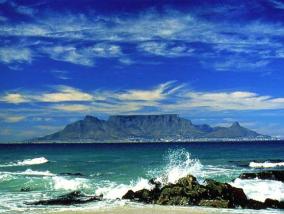 South Africa is one of the most popular tourist destinations. Diverse and rich nature: an endless change of breathtaking landscapes - from deserts covered with exuberant splendor flowering plants spring before mountain peaks and hilly plains, savannas and bush with a huge variety of African fauna. There are excellent opportunities for observing animals and a large number of tourist routes for eco-tourism. And finally - in South Africa you will see the coasts of two oceans at once - the Atlantic and the Indian.
South Africa is one of the most popular tourist destinations. Diverse and rich nature: an endless change of breathtaking landscapes - from deserts covered with exuberant splendor flowering plants spring before mountain peaks and hilly plains, savannas and bush with a huge variety of African fauna. There are excellent opportunities for observing animals and a large number of tourist routes for eco-tourism. And finally - in South Africa you will see the coasts of two oceans at once - the Atlantic and the Indian.
Here you will find representatives of almost every culture in South Africa there is!
South Africa is an amazing, interesting country!
Not only modern, but also the most oldest monuments of humanity can be found in this country. For example, the oldest archaeological sites found in South Africa date back to 2.5 million years old (Australopithecus Africanus), including the remains of a modern man about 150 thousand years old (the mouth of the Clazies River).
Getting to know South Africa
For those who are preparing for a vacation in South Africa, or are going to make independent travel to this country, the information on these pages will be interesting and useful.
To view more detailed information about the country (on the aspects of your interest - nature, weather, population, addresses of embassies, currency ...) use the left column of the menu of our site.
Using the catalog of hotels in cities in South Africa (menu items Tourist centers and Attractions), you can book a room in the place you like directly through our website.
For a more visual perception of information about South Africa, the site has a photo gallery of the country.
So, let's go to South Africa!

